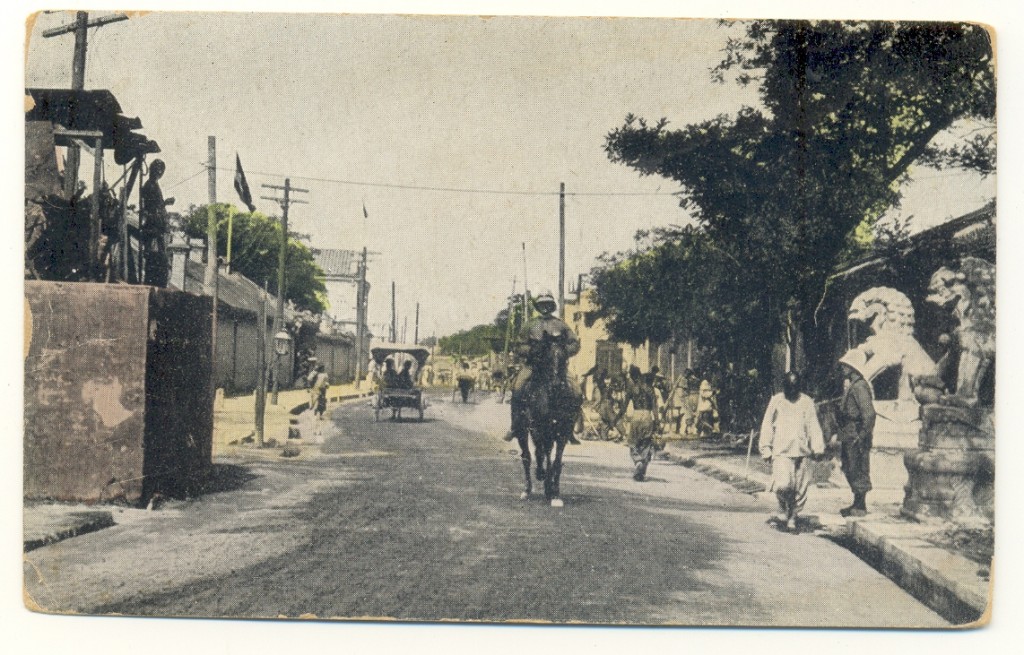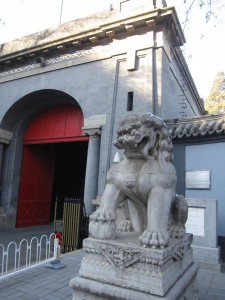Posted: August 23rd, 2011 | 1 Comment »
Somehow I missed this Beato exhibition that just took place, and is now finished, in Los Angeles at the John Paul Getty Museum. Beato of course was one of the earliest photographers of China who liked a bit of gore and was prolific and highly commercial. I wrote about him in some detail in my Through the Looking Glass book though I believe his final days are still shrouded in some mystery.
Anyway,there’s an essay looking at Beato’s body of work and the exhibition highlights in the latest online version of the China Heritage Quarterly.

Posted: August 22nd, 2011 | 1 Comment »
Following my post a while back on the old and now seemingly lost Studley Avenue in Hongkou the street photographer Sue Anne Tay (with her great Shanghai Street Stories blog) emailed to tell me about a building close to the site on north to south running Lintong Road (formerly McGregor Road). It is one of only a few now sadly relatively intact privately built compounds in that area. There used to be many more but in the last decade the wrecking ball has had pretty much enjoyed free reign across all of Hongkou, Tilanqiao and Yangpu (tourists and foreigners by and large don’t go north east of Suzhou Creek so many people haven’t even registered the extent of destruction over there.
Anyway, here’s Sue Anne:
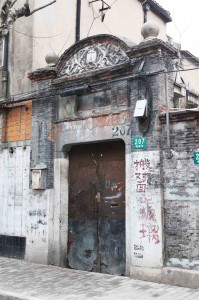
This is a beautiful entrance along Lintong Lu, leading towards Yulin Lu. There is a story behind this house, built in the simplistic Suzhou-styled rural design. I ran into the owner though I lost my notes and his name. It turns out the the whole house was owned by one family, whose patriarch worked for foreign companies or “æ´‹è¡Œ” (or the industry involving foreign businesses) and designed the entire structure himself. The family also owned the the opposing apartments where each son had owned a house. They lost it all during Communism including many relatives, and were relegated to a small adjacent apartment. Now the plot, as seen from the bird’s eye view (immediately below), is split into two families who don’t really speak to each other. One side has kept the traditional facade though horribly defaced (see picture above) and the other has a metal gate (see second picture below).
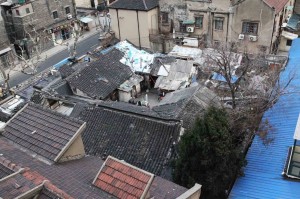
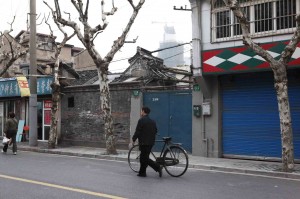
The ornate entrance is the left entrance. Shame I don’t have a “contrast” photo of the two entrances – old vs modern. One of the brothers live on the right, and the sister lives on the left. They are separated by a giant structure in the middle which now serves as a shed that was once the main room (see picture immediately below). As you can see from the other photos, the house is now half-torn down (see bottom picture). If I recall right, the developer came and starting going at it and somehow ran out of money. These pictures were taken January 2010, so I don’t know if it’s still in the same state.
(China Rhyming – as my photo from the street outside in the Studley Avenue post taken in August 2011 shows the dereliction has just been left – the damage done through one or two, and another upcoming, Shanghai winter with a smashed roof is probably now irreparable)
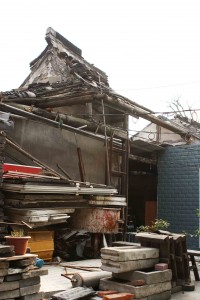
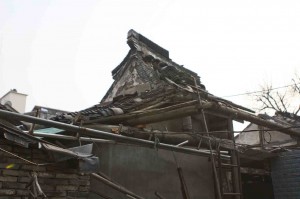
Posted: August 21st, 2011 | No Comments »
This is quite funny and a legitimate chance to plug the excellent Koryo Tours for anyone thinking of heading to North Korea on holiday – don’t even think of going with anyone else.

Aahh, the dear old Ryugyong Hotel – how many of us have stayed in the rather run down Koryo Hotel or the leper colony island that is the Yanggakdo Hotel and dreamt that one day North Korea would finally finish the Ryugyong and we could stay in what would obviously be Pyongang’s coolest hotel, though hardly boutique I must admit!
Some more Ryugyong and Shard facts from the team at Koryo in Beijing:
The Ryugyong was designed in 1987 and is an exaggerated pyramid shape covered in glass. The Shard was designed in  2000 to look like a shard (umm or an exaggerated pyramid shape covered in glass)
Ryugyong hotel to be completed in 2012 (at least on the outside) Â – Shard to be completed in May 2012
Ryugyong has 105 storeys  the Shard has 72 useable floors (15 additional radiator floors)
Ryugyong is the 39th tallest building in the world , the Shard is the 45th tallest building in the world.
Permission to build the Ryugyong hotel was granted by North Korean leader Kim Il Sung, Development  plans for the Shard were opposed by local authorities and heritage bodies but in 2003 British Deputy Prime Minister John Prescott (the supposed arbiter of good taste) announced that construction had been approved.
The Ryugyong has a lift travelling up the outside edge of the building. The Shard (pathetically!) does not.
The Ryugyong has 5 revolving restaurants. The Shard has a viewing gallery and open-air observation deck on the top (72nd) floor.
In 2008 Ryugyong Hotel project was restarted with investment from an Egyptian company Orascom. In January 2008, it was announced that a consortium of Qatari investors had paid £150m to secure an 80% stake in the Shard.
So, wanna go DPRK?
then go with Koryo
www.koryogroup.com
info@koryogroup.com

Posted: August 21st, 2011 | No Comments »
I’ve posted a few times on one of my great Shanghailander heroes, the Frenchman Roderick Egal who was one of the few residents of Shanghai Frenchtown to join the Gaullist resistance while most appear to have just sat back and tolerated Vichy. It has to be said that the French population of the Concession was not exactly crowned in glory for their behaviour falling the Fall of France – they were overwhelmingly pro-Vichy. However Roderick Egal, and others, responded to de Gaulle’s Appeal of 18 June 1940 to resist and established an organisation and a clandestine press to fight back. Many were arrested and hunted by the pro-Vichy police with the help of the Nazis in Shanghai too. It was a time of stark sides – collaboration or resistance. Many Frenchtown residents said you could not fight what they felt was the inevitable conquering of France by Germany and that Petain was only being pragmatic – Egal begged to differ.
He was also arrested eventually, taken to Hanoi in French (Vichy-controlled) Indo-China where the British managed to get him freed and on a boat to Hong Kong. After that he fought with the British at the final defense of Hong Kong during the bloody Battle of North Point, he was interned in Kowloon and eventually died in Hong Kong in 1947. The war and his dogged resistance to the Nazis and Japanese was not kind to his health.
And so I noticed in the online Le Souvenir Francais de China a small piece about the memorial in Stanley Military Cemetery (below) to the French in Hong Kong who resisted and did not accept either the German occupation of France or Vichy treachery. Egal is noted – ‘…fait prisonnier, interné à Kowloon et décédé le 29 décembre 1947 après près de 4 ans en détention’
Here’s the article and some pictures of the memorial.

Posted: August 20th, 2011 | No Comments »
A piece on Shanghai street photographer Sue Anne Tay’s blog about the “renovation” currently ongoing at the old Majestic ballroom and cinema on Jiangning Lu (formerly Gordon Road). The exterior is, it seems, to be left alone but what on earth is happening to the interior is anyone’s guess – this is the problem with a lot of “renovations” in Shanghai as while facades have some degree of protection, interiors do not. Hence the interior vandalism at numerous Bund properties including Three on the Bund etc. I’ll post soon on the renovation along the tiny sliver of the old French Bund (Quai de France) that remains at No.22 where again the facade remains and has been cleaned quite nicely but inside…well, wait and see for yourself…but I warn you, it ain’t pretty!
I have some pictures of the lobby and interior of the Majestic from about 10 years ago somewhere but, of course, can’t find them. Certainly the lobby was still quite nice when i last went in a couple of years ago and the theatre too (full of kids at the time screaming at The Wiggles when they came to China). Anyway, Sue Anne has some pics of the exterior on her site and she’s a real photographer. But here’s an old shot of the Majestic from around the time it was built. As it was completed in the somewhat troublesome year of 1941 it missed the great heyday of Shanghai nightlife.

Posted: August 19th, 2011 | No Comments »
According to the gossip columns in the London papers we might never get to see the long-awaited (or perhaps feared) Madonna-directed biopic of that most famous of Shanghai sojourners Wallis Simpson. And apparently her notorious Shanghai days (and slightly less notorious Peking days) are omitted altogether it seems – so no scene of Wallis learning the infamous Shanghai Grip (and if you don’t know what that is then do try and get out more) in a Kiangse Road knocking shop. And also no mention of those long-rumoured yet never publicly revealed smutty pictures she apparently posed for while in Shanghai.
Still, it seems the film – W.E. – will be premiered at the Toronto Film Festival in September if Harvey Weinstein (no less) can finish the edit he himself is reportedly undertaking due to the original cuts total awfulness. Critics in London have been sniping that there is no saving the movie sadly. Especially sad as I thought Andrea Riseborough would make a great Wallis anywhere from Shanghai to Cannes – let’s face it any actress who can make Maggie Thatcher look a bit sexy (which she did as a young Margaret in The Long Walk to Finchley), was brilliant in The Devil’s Whore and was such a superb Rose in the recent Brighton Rock remake should do well as Wallis.
But it looks like the film will get panned and Wallis doing the Shanghai Grip unfilmed. As to when the film will be on at your local Odeon, that’s anyone’s guess.

Posted: August 18th, 2011 | No Comments »
A new addition to the Royal Asiatic Society Hong Kong Studies series:
Hugh Baker
Royal Asiatic Society Hong Kong Studies Series

“Professor Baker makes it possible to recognise what still remains of the architecture, agriculture and traditional dress of this historic area and also to understand something of the unique way of life followed here for a thousand years that is now steadily giving way to urbanisation and uniformity.” – From the Foreword by Lady Youde
- The 120 articles and photographs investigate religion, food, language, history, festivals, family, strange happenings and clan warfare in Hong Kong.
– How do you ascend a pagoda with no staircase? How can you marry without attending the wedding? When is it wrong to buy a book? Hugh Baker answers these and many other questions.
- A well-rounded picture of a vibrant, quirky people painted with affection and informed by many years of scholarship and research.
Hugh Baker is Emeritus Professor of Chinese at the School of Oriental and African Studies, University of London. He has published books on Chinese kinship, Hong Kong history and culture, the overseas Chinese, and the Cantonese and Mandarin languages.
Posted: August 17th, 2011 | No Comments »
This picture, an old postcard, I came across recently claims to be a picture of Peking’s Legation Street (now Dongjiaominxiang) just prior to the Boxer attacks in 1900. This shows a far less developed Legation Quarter than after the rebuilding that followed the 1900 Siege. This shot appears to be facing to the west and the building on the right is the French Legation with the trademark statues at the entrance (still there, see below, despite the former Legation being Chinese government offices now). After rebuilding the statues remained though the entry gate became far more impressive (and impregnable). The splendid tree is now long gone, presumably to make way for the French (International) Post Office building which remains today as a rather shabby Sichuan restaurant but a great structure. The structure opposite is the German Legation while the building in the distance to the right is, I think, the original Hong Kong and Shanghai Bank building.
Several other things worth noticing are obviosuly the foreign soldier on horseback and the foreign soldier on guard outside the French Legation. There are probably more Chinese on the street than might have been expected after 1900 when it became more difficult for Chinese to enter and move around the Legation Quarter without good reason. In fact the photographer here is probably standing outside what was then, on the left of the picture and adjacent to the German Legation, a small park (or gardens) and some Chinese style and occupied houses as well as the original location of the Peking Club. These were swept away after 1900 becoming the Belgian Legation for a time around 1912. The final thing worth noting is that telegraph wires and poles had already come to the Legation Quarter.
